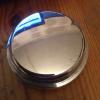No, it seems that neither Somerford nor M-Machine list it, nor do Heritage, although they must be fitting then in new shells! I suspect that they must come fitted to the flanged ends of the bulkhead crossmember.
There are a number of things to consider here. Firstly, you need to know what grade of steel it must be, and mild steel is not adequate. The limitation is that for safe bolting, the bolts MUST snap before the female threads strip, so that there is a clear indication of failure. The bolts really need to be grade 8.8, which means that the bar must be made of at least the same grade of material as the matching nuts for grade 8.8 bolts (not actually the same steel as the bolts).
Now before some non-engineer comes along and says that you just don't torque the bolts up to stripping point, I will explain that those particular small bolts (1/4" UNF) are perfectly safe in a normal Mini, with standard or even mildly uprated dampers and rubber cone springs, but are in no way safe for handling the spring plus damper load if using coilovers. (Coilovers are totally unsuitable for road cars anyway, as has been explained here many times, but that is another topic...) In all cases, the bolts, necessarily actually set screws because of their short length, are not "fitted" bolts, in reamed holes, and cannot carry the load in shear, so it is carried by friction between the damper mount bracket and the inner wing, the bolts only providing the very high clamping load that is necessary, so they MUST be torqued up correctly, at which point a mild steel bar will be perilously close to stripping.
So, to keep life simple, I would use a mild steel bar, drilled with two plain holes, and weld grade 8.8 nuts to the back. Then you have the bar as the load spreader, which is essential and within the capabilities of mild steel, and the proper nut material, also essential, without getting involved in procuring, drilling and tapping some exotic steel. And, if you are doing that, you can make a small improvement by using actual bolts, not set screws, which will engage closely with the carefully drilled holes in the bar. Also consider using grade 10.9 capheads (do not use grade 12.9, it lacks ductility) and matching nuts, and upping the bolt torque by 25%.
The mild steel bar can be safely MIG welded to the shell in the usual way, although the welds are only needed to keep them in position during assembly. When welding a grade 8.8 nut, and even more so, a grade 10.9 nut, a zero hydrogen process is essential to avoid serious embrittlement, i.e. no trace of oil, paint or moisture, and scrupulously clean MIG wire (some has a lubricant applied during manufacture, which is bad) or a low hydrogen 7018 arc welding rod. But you only need two opposing tack welds between nut and bar, don't go for a full weld.
It is probably quicker to actually do than write about it, the welding only takes seconds once all the bits have been made. I would do it on the bench, using the damper bracket as a jig to get the hole spacing correct, then bolt up the bracket through the bar, to hold the nuts against the bar firmly, and a couple of seconds of weld will fix the nuts permanently. Then I would put the bars (two, top and bottom) in the car, bolt the bracket in place, and put a few MIG tacks between bars and shell to keep them there. Then I would take the mount off again and paint and rustproof the entire area.
If I was daft enough to use coilovers on the road, I would be upgrading the bolts to at least 5/16" UNF grade 10.9, and for that, you have to file out the holes as the centres will have to move slightly. Actually I have even dafter plans, something better than coilovers, but that is a long way off yet, and if it works out, it will of course be posted to the forum.

















